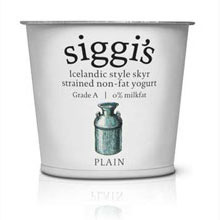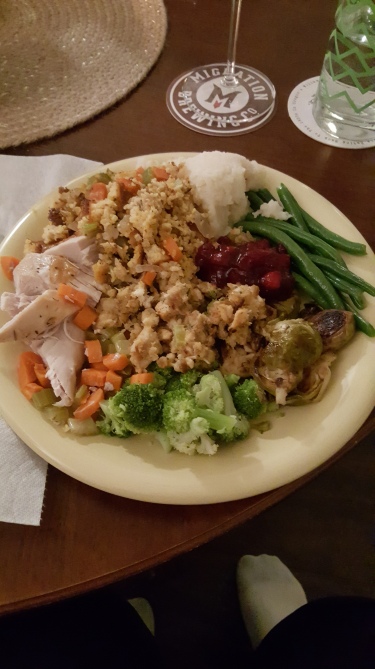My love affair with yogurt dates back many years.
I’d always considered the creamy delicacy a fairly healthy choice. Unbeknownst to me, those weekly cups of yogurt were a dietitian’s nightmare; they packed a whopping 27-33 grams of sugar and 30+ grams of carbohydrates per serving, in exchange for maybe 6g of protein and nearly 200 calories. Yet I was fooled into thinking they were good for me for two reasons: they were labeled “lowfat” and I never paid much attention to labels, anyway. Despite Tara’s warnings.
Nowadays, I’m much more health conscious, severely limiting my sugar and carb intake. Following my diabetes diagnosis I learned that “regular” yogurt was off-limits, but Greek yogurt was a perfectly acceptable substitute. The only downside? I found the sour flavor off-putting. But a funny thing happened on the road to a healthy recovery: I grew to like Greek yogurt. A lot, as a matter of fact. I consider myself somewhat of an expert, especially after the past month.
Greek yogurt differs from regular yogurt in that the liquid whey is strained off, resulting in a thicker, richer, and creamier texture and consistency (this also explains the extra tartness). The straining process removes some of the lactose, making Greek yogurt much lower in sugar than the regular stuff; in addition, it’s got double the protein, half the carbs, and half the sodium of regular yogurt. For the uninitiated, the more protein a food has, the more “full” you feel after eating it. This is good for weight loss; the longer you feel satiated, the less likely you are to indulge in between-meal snacks. Other benefits of Greek yogurt: it’s chock full of probiotics, which aid in digestion and boost the immune system; it’s high in calcium, important for strong muscles and bones; and is a great source of potassium and vitamin B-12. Greek yogurt is an excellent substitute for mayonnaise, sour cream, butter, oil, and cream cheese. Pretty much the perfect food, no?
Well…as long as you choose wisely. Go for plain yogurt with few and simple ingredients, avoid added sugars and artificial ingredients, and remember: the more protein, the better. So that artificially flavored Strawberry Cheesecake Greek yogurt might taste indulgent, but it’s hardly a healthy choice. And despite past recommendations to the contrary, a little fat is good. It keeps you feeling fuller longer and can actually help you lose weight in the long run. Crazy concept for many to grasp, I know.
With all this in mind, I set out to find the perfect Greek yogurt. Dannon Light ‘n Fit was my gateway Greek yogurt drug, if you will, until I looked at the label and learned it wasn’t so good for you. A little bit of research pointed me in the right direction, and for the past month I have been eating a lot of Greek yogurt. All in the name of science, kids! To keep the playing field level, I stuck with plain, though I did try different variations that included fat-free, low-fat, and full-fat options. The brands I tried were: Dannon, Fage, Zoi, Wallaby Organic, Stonyfield Farms, Maple Hill Creamery, Blue Isle, Siggi’s, and Trader Joe’s. There were wide variations in flavor and texture between them all – much more so than I’d initially anticipated. Narrowing down my favorites, in order, was a daunting task, especially when it came to choosing an overall winner. In fact, I ended up soliciting the input of four coworkers, all of whom attacked the challenge with gusto. While no brand was the unanimous victor, there was enough of a general consensus to help me rank them. Without further ado, here are my Top 5 choices for Best Greek* Yogurt, taking into account both taste and nutrition.
Actually, there will be a little ado before I get to the best. First off, a couple I didn’t care for.
- Zoi Nonfat Plain Greek Yogurt A coworker recommended this one, but I was not impressed. Though I wasn’t looking at sodium content, this brand was incredibly salty and the consistency was thin and watery. I did not care for it at all.
- Maple Hill Creamery Plain Greek Yogurt. I had high hopes for this one because of the fact that it’s made with 100% grass-fed cow’s milk. It’s a whole milk so it’s pretty rich and decadent, but all I tasted was grass.
These were decent, but not my favorites. We’ll call them honorable mentions.
And now…showtime!
5. Stonyfield Organic Whole Milk Plain Greek Yogurt. As a general rule, the whole milk yogurts we tried were the most flavorful and decadent of the bunch. Stonyfield’s Greek yogurts are certified USDA organic and made from pasture-raised cows. They are non-GMO, gluten-free, and kosher certified, so your conscience can certainly rest at ease. One container has 120 calories, 5g of sugar, and 14g of protein. Tangy and rich, but in our blind taste test, this one finished behind the others.

4. Blue Isle Whole Milk Plain Greek Yogurt. Blue Isle is best known for their award-winning Greek yogurt spreads, having only recently expanded into actual Greek yogurt. This one was creamy and smooth and the flavor was a little less tangier than others, which may explain why two of us chose it as our favorite in the blind portion of our taste test. It’s got 110 calories and 4g of sugar, very impressive for a whole milk yogurt, but unfortunately contains only 7g of protein. It also is made with whey protein concentrate and pectin – odd additions, considering most of the others we tasted consisted only of milk (and cream in some cases) and live cultures.

3. Wallaby Organic Whole Milk Plain Greek Yogurt. This variety is only available in a 32-ounce container, but you can get around that by buying one of the Purely Unsweetened options and leaving out the fruit, which is what we did for our test. It’s worth the effort, too – this flavor received the most votes in the blind portion of our taste test. We found it to be rich, creamy, and smooth, with just the right note of sourness. At 120 calories and 5g of sugar it compares favorably with the others, but its protein content (10g) is a little less impressive than the top two. Regardless, this is a very good yogurt made with cultured pasteurized organic milk and cream, and with only 5g of fat is worth the splurge over the 2% version.

2. Fage Total 2% Plain Greek Yogurt. Fage is one of the best-known and most popular Greek yogurt brands in the U.S., and with good reason: their yogurt is very good, bordering on decadent. It hits all the right flavor notes – creamy, smooth, and rich, with a tanginess that makes you take notice but does not overwhelm – and has probably the best consistency and texture out of the group, thick but not overly so. It’s a great general-purpose Greek yogurt that is delicious on its own and as a topping. The container is a little larger than the other varieties (7 oz. versus the standard 5.3 oz.) so the calories (150) and sugar content (8g) are a little higher, but so is the protein (20 g). Its ingredients list is impressively short and simple: Grade A pasteurized skim milk and cream and live active cultures. Because it’s a 2% yogurt it’s lower in fat (4g) but proof that you don’t have to sacrifice taste. The only drawback? The fact that it’s not organic. This could very well have been my #1 choice, but in a tight race, that distinction goes to…

1. Siggi’s Icelandic style Skyr Plain Strained Non-fat Yogurt. How can a non-Greek yogurt finish first in a sampling of Greek yogurts? Simple: what we call Greek yogurt in the U.S., the rest of the world calls strained yogurt. Icelandic-style Skyr is, for all intents and purposes, as “Greek” as most of the others on our list. I’ll admit I did not realize this myself when first embarking upon my quest, and while I have been a fan of Siggi’s for awhile now, did not initially include it in my testing. Until I discovered that loophole. What’s to love about Siggi’s? Pretty much everything. The whole product line is very low in sugar, making even the flavored varieties surprisingly nutritious choices (they contain only 9-11g of sugar and are flavored with natural fruit and agave nectar or cane sugar). There are nonfat, low-fat and whole milk varieties, in unique flavors including strawberry and rhubarb, mixed berries and acai, and pumpkin spice, and all are reasonably healthy. Our plain nonfat variety has a mere 100 calories and 3g of sugar, and packs in 17g of protein, making it the clear nutritional powerhouse of the group. The yogurt itself is also thicker than the others (you’ll have no problem standing a spoon straight up in it) and has a distinctively sharp bite, but is very creamy and feels more like a treat than the other brands. This all-natural yogurt is made of milk from grass-fed cows and boasts no aspartame or sucralose, no gelatin, no artificial colorings, no preservatives, no high fructose corn syrup. And it’s verified non-GMO. All these factors combine to make it the best of the best.

 Frigo is probably the best-known brand. Their “Cheese Heads” in the familiar green packaging have been around for eons, and there is a good reason: they were the unanimous favorite among all four testers. We found the Frigo pleasantly cheesy, with a creamy yet pliable texture that was easy to peel. One person remarked that Frigo “tastes like childhood,” and I’m inclined to agree.
Frigo is probably the best-known brand. Their “Cheese Heads” in the familiar green packaging have been around for eons, and there is a good reason: they were the unanimous favorite among all four testers. We found the Frigo pleasantly cheesy, with a creamy yet pliable texture that was easy to peel. One person remarked that Frigo “tastes like childhood,” and I’m inclined to agree.





















